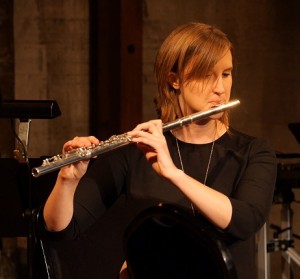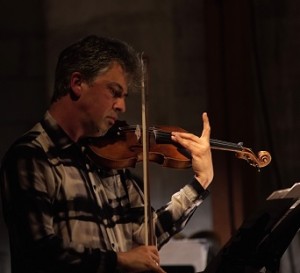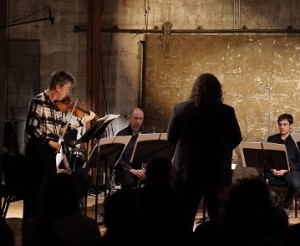 On October 30, 2015 WasteLAnd presented Study for Eurydice, a concert at Art Share LA in downtown Los Angeles. A nice Friday night crowd filled the restored industrial performance space for an evening of new music.
On October 30, 2015 WasteLAnd presented Study for Eurydice, a concert at Art Share LA in downtown Los Angeles. A nice Friday night crowd filled the restored industrial performance space for an evening of new music.
The first piece, Relay/Replay by Yiheng Yvonne Wu, featured Rachel Beetz on flute. A computer played recorded flute sounds through speakers mounted above the performance area. Relay/Replay began with a brief high-pitched tone from one of the speakers, answered in kind by the flute. A short silence followed and the sequence repeated. A pattern of call and answer continued and the electronic part gradually changed as the replies by the became more varied as if a conversation were occurring in a different language. A low trill from the flute was mimicked by similar sounds from the speaker, like birds calling back and forth. Towards the end of the piece there were sounds from both speakers that ultimately resolved into a low, pure tone. This was actually a recording of the flute – greatly slowed down – that added a mysterious feel. The flute passages that followed felt more organic and brighter by contrast. The low tone increased in volume, becoming dominant and more assertive as the piece ended. Relay/Replay is an intriguing combination of flute playing and electronic sounds derived from the flute, artfully uncovering both similarities and differences.
Susurrus by Panayiotis Kokoras for violin, cello and piano followed, beginning with a series of sharp rapping sounds from the players on their respective instruments. The result was a sort of unsettled clatter that was soon joined by the amplified strumming of strings inside the piano. There was an active and tense feel to all of this – there were no musical tones heard initially, but rather the rhythmic rattle of various extended percussive techniques. Eventually a sustained cello note was heard that slowly decreased in pitch and some piano strings were plucked to form identifiable notes. At one point the musicians voiced the sounds of rushing air using their breath and this added a remote, windswept feeling to the proceedings. Apart from a few notes heard now and then, there was no conventional melody, beat or regular rhythm and this gave an edgy, feral feel to the ensemble. The coordination between the players here was remarkable given how far this piece stands outside the bounds of conventional music. Susurrus is a journey that takes the listener past the limits of ordinary musical practice and into to new levels of expression.

